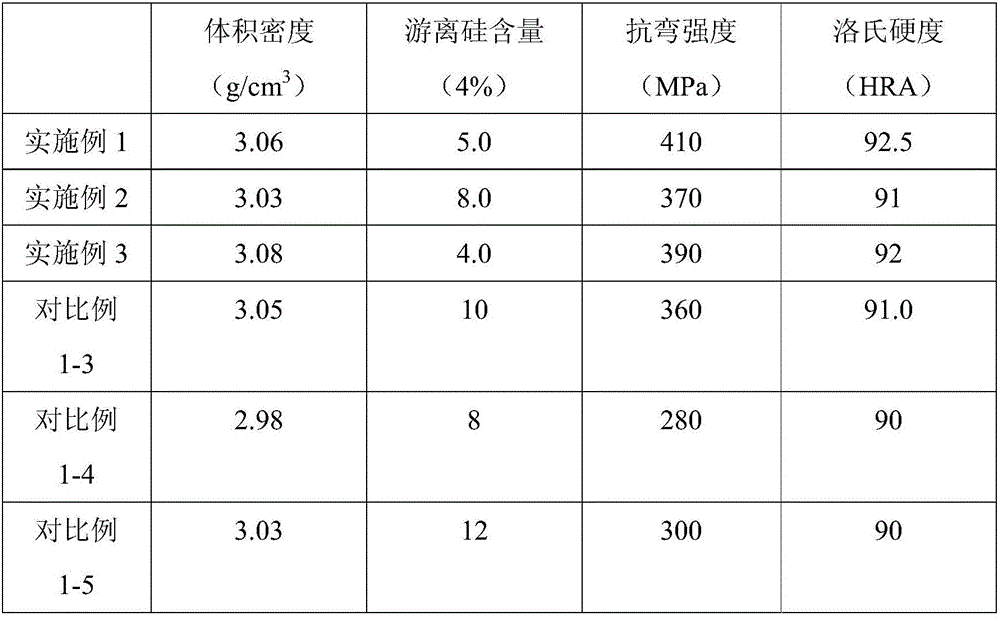Method for preparing fine-grain silicon carbide ceramic through reaction sintering
A silicon carbide ceramic and sintered silicon carbide technology, which is applied in the field of inorganic non-metallic materials, can solve the problems of restricting the practical scope, decreasing the mechanical strength of materials, and high content of free silicon, achieving scientific and reasonable raw material ratio, improving mechanical strength, microscopic The effect of uniform structure
- Summary
- Abstract
- Description
- Claims
- Application Information
AI Technical Summary
Problems solved by technology
Method used
Image
Examples
Embodiment 1
[0053] Embodiment 1, a kind of reaction sintering is prepared the production method of fine grain silicon carbide ceramics, carries out following steps successively:
[0054] 1), preparation of main ingredients:
[0055] The main material is composed of the following components by weight: 85% of green silicon carbide micropowder (SiC micropowder), 15% of activated carbon powder;
[0056] The green silicon carbide powder D 50 = 5 μm;
[0057] The particle size of the activated carbon micropowder is 20-100nm;
[0058] 2), ball mill mixing:
[0059] Use deionized water as the solvent and silicon carbide balls as the ball milling medium to carry out wet ball milling mixing; the details are as follows:
[0060] First add 1 part of dispersant and 50 parts of deionized water to 100 parts of the main material, and then add 15 parts of an aqueous solution of organic matter with high-temperature residual carbon in sequence (in this aqueous solution, the mass concentration of organic...
Embodiment 2
[0081] Embodiment 2, change "green silicon carbide micropowder (SiC micropowder) 85%, activated carbon powder 15%" in step 1) of embodiment 1 to "green silicon carbide micropowder (SiC micropowder) 90%, activated carbon powder 10%"; All the other are equal to embodiment 1; Its performance testing result is: the drainage method detects that bulk density is 3.03g / cm 3 , free silicon content 8.0%, flexural strength 370MPa, Rockwell hardness (HRA) 91.
Embodiment 3
[0082] Embodiment 3: Change "green silicon carbide micropowder (SiC micropowder) 85%, activated carbon powder 15%" in embodiment 1 step 1) to "green silicon carbide micropowder (SiC micropowder) 80%, activated carbon powder 20%" and the rest Identical to embodiment 1; Its performance testing result is: the drainage method detects that bulk density is 3.08g / cm 3 , the content of free silicon is 4.0%, the flexural strength is 390MPa, and the Rockwell hardness (HRA) is 92.0.
[0083] Comparative example 1-1, cancel the use of "15 parts of high-temperature organic carbon residue aqueous solution" in step 2) of embodiment 1, and the rest are equal to embodiment 1, but in step 6) during the car-making process, the green body is easy to crack , can not be turned normally, mainly because the high-temperature residual carbon organic matter of the present invention is cracked into network carbon during the wax removal process, which enhances the strength of the green body.
PUM
| Property | Measurement | Unit |
|---|---|---|
| particle diameter | aaaaa | aaaaa |
| particle size | aaaaa | aaaaa |
| particle diameter | aaaaa | aaaaa |
Abstract
Description
Claims
Application Information
 Login to View More
Login to View More - R&D
- Intellectual Property
- Life Sciences
- Materials
- Tech Scout
- Unparalleled Data Quality
- Higher Quality Content
- 60% Fewer Hallucinations
Browse by: Latest US Patents, China's latest patents, Technical Efficacy Thesaurus, Application Domain, Technology Topic, Popular Technical Reports.
© 2025 PatSnap. All rights reserved.Legal|Privacy policy|Modern Slavery Act Transparency Statement|Sitemap|About US| Contact US: help@patsnap.com

